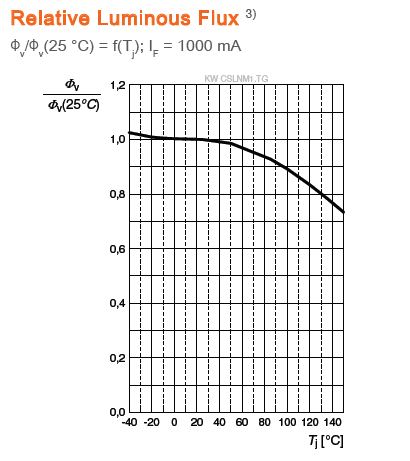Thanks for the testing djozz and to The OnlyDoc for donating them.
So these would outperform the XPE2 green led by a long shot?
@MRsDNF
Yup it ourperforms the XPE2 and the LCG H9RN.
And what is more interesting, this new led can handle a huge amount of current (way over spec).
If the boost HX reacts similar it will be a huge bump.
Guess they are on point with their advertising:
OSLON Boost HX makes use of the high current capability of the latest chip generation in a thermal optimized package.
Can not wait to see one in a aspheric or a very good reflector (like the GTmicro).
Thanks for the test. Nice LED for those lumen hunters. ![]()
That is interesting about the higher current-handling ability. I thought this is basically the same as the white flat but with different phosphor? So the chip and thermal path down should be the same. Could it be that the white light phosphor produces a lot more heat than the green phosphor and that is the source of the difference?
Strictly it is not a green led and the light looks different too. But if that is not relevant its luminance is higher than anything there was before, including all white leds.
I think between his efficiency comment, the lumens being higher and spectral chart being so narrow that is likely exactly what he is trying to say ![]()

Albeit it looks pretty good this one is still untested around here: http://kaidomain.com/S027435-DIY-LED-Flashlight-Host-130mm-x-47_5mm-Black

I mean it looks OK but if it doesn’t beat the Z1 it doesn’t interest me. A fixed thrower aspheric with a slightly larger lens would be even better.
thanks for the test!good results.
White flat and "Green" flat have the same thermal resistance, so max. currents should be similar, green flat peak could be a little bit higher (0.5-1A) due to higher efficiency and lower phosphor loss.
So I think this confirms your white flat test was probably with sub-optimally reflowed LED since I got 5.75A peak, almost 1A higher than what your test shows.
Yes, I considered that. Funny thing is that this time the reflow was done with less care (more solder) than with the White Flat test. So I do not rule out that this difference is real. I may re-do the White Flat test although it is less fun to re-test stuff than something new :weary: (and it costs me another led, ).
).
How about this: I'd like to send you 9 LEDs, 3 soldered by me, 6 bare + 6 3030-20 DTP boards + small amount of lead free solder. You should solder 3 LEDs with your lead paste, and other 3 with my lead free paste.
So you could finally test lead vs. lead free solder,and also see if soldering technique has any visible effect, white flat is best LED for that test since it has smallest thermal pad (3x1mm) and highest power density (W/mm2).
3LEDs for each test is to eliminate "luck" during soldering and LED thermal resistance variance.
That is quite a few hours of testing but it sounds like that will generate some useful data, let’s do that. But we can not set a hard deadline for this, having a family, and with always the possibility for the need of extra care for my son, my hobby-time can spontaneously evaporate at any time, so things must be postponable.
Wow, that is some hardcore BLF cooperation :+1: :+1:
Is there a red version available, too?
Is there a red version available, too?
there is the KR CSLNM1.23
datasheet: https://dammedia.osram.info/media/resource/hires/osram-dam-5961110/KR%20CSLNM1.23_EN.pdf
617nm, up to 2500 mA and then just over 300 lumen. Probably an upgrade over the red XP-E2 but it is not a phosfor-converted red but a classic single wavelength led. I expect it can not be overdriven like blue leds can.
Wow, this is pretty interesting... Would be interested in getting a couple of these when available.
Looking at datasheets, two graphs (output vs current and output vs temp) also show that green flat looses output slower than white flat at higher currents and higher temperatures, which is in agreement with djozz' measurements(left white flat, right green flat):




One interesting thing is green flat output reaches max. at ~40-50C, but it's only 1-2% higher compared to 20C.
The relative flux looks almost identical to me (2.4times at 3A for both) ?
Green flat is a little bit closer to 2.5 than white flat, difference is small, temperature has much more visible effect, at 100C white flat is at ~89%, green flat at ~94%.
Thanks for this very interesting test!
So the luminance is around 400cd/mm^2 or even above that!
Unfortunately it has a green tint ![]()